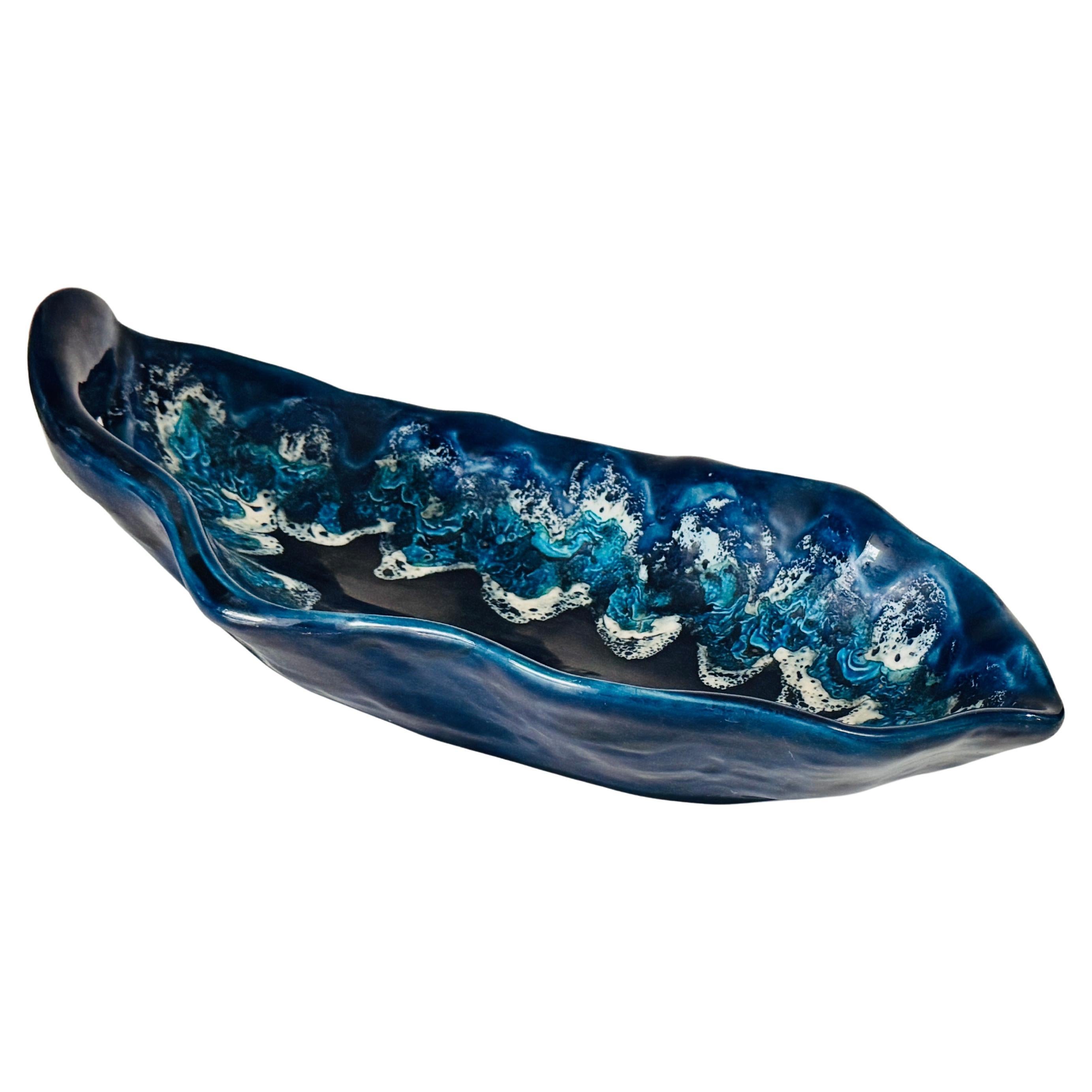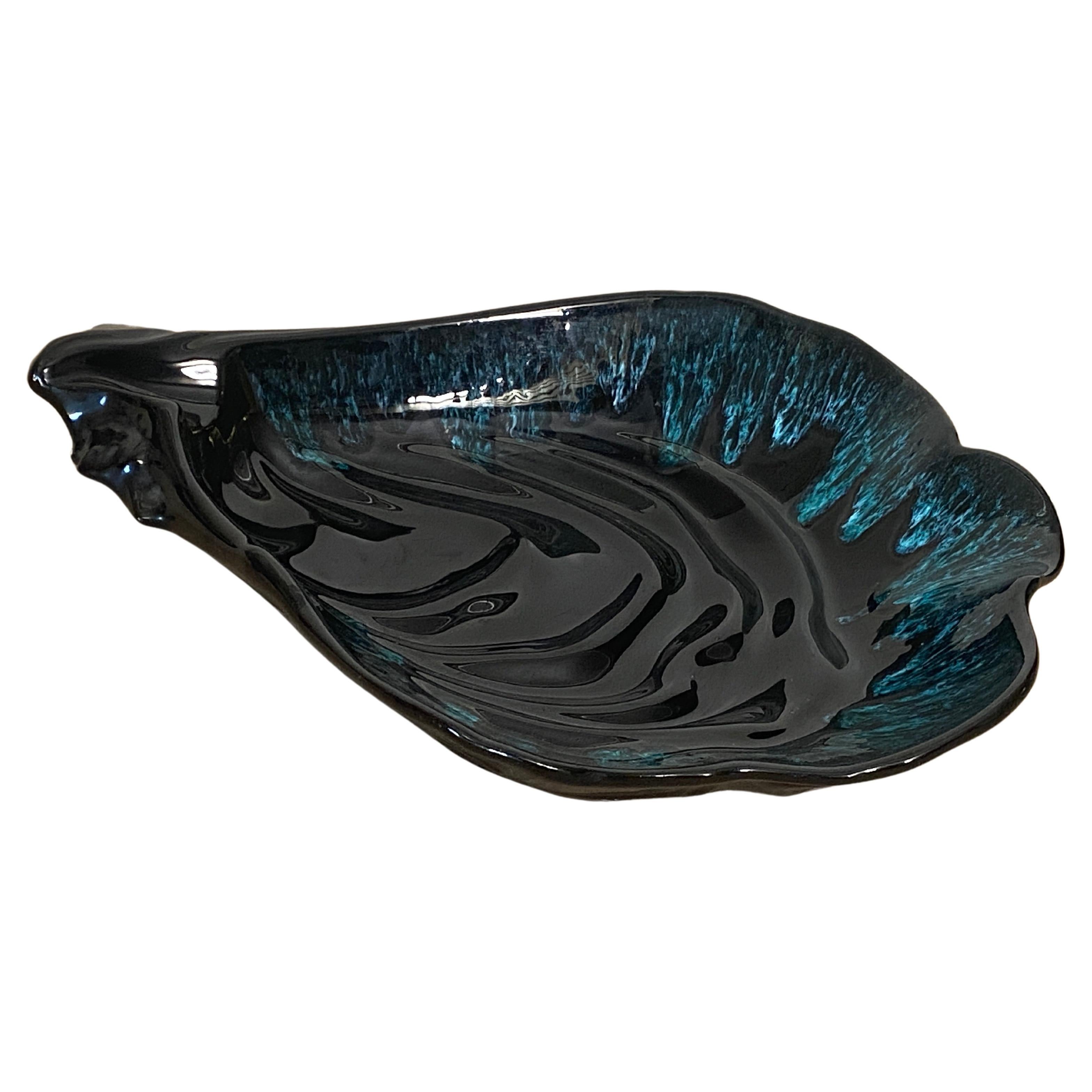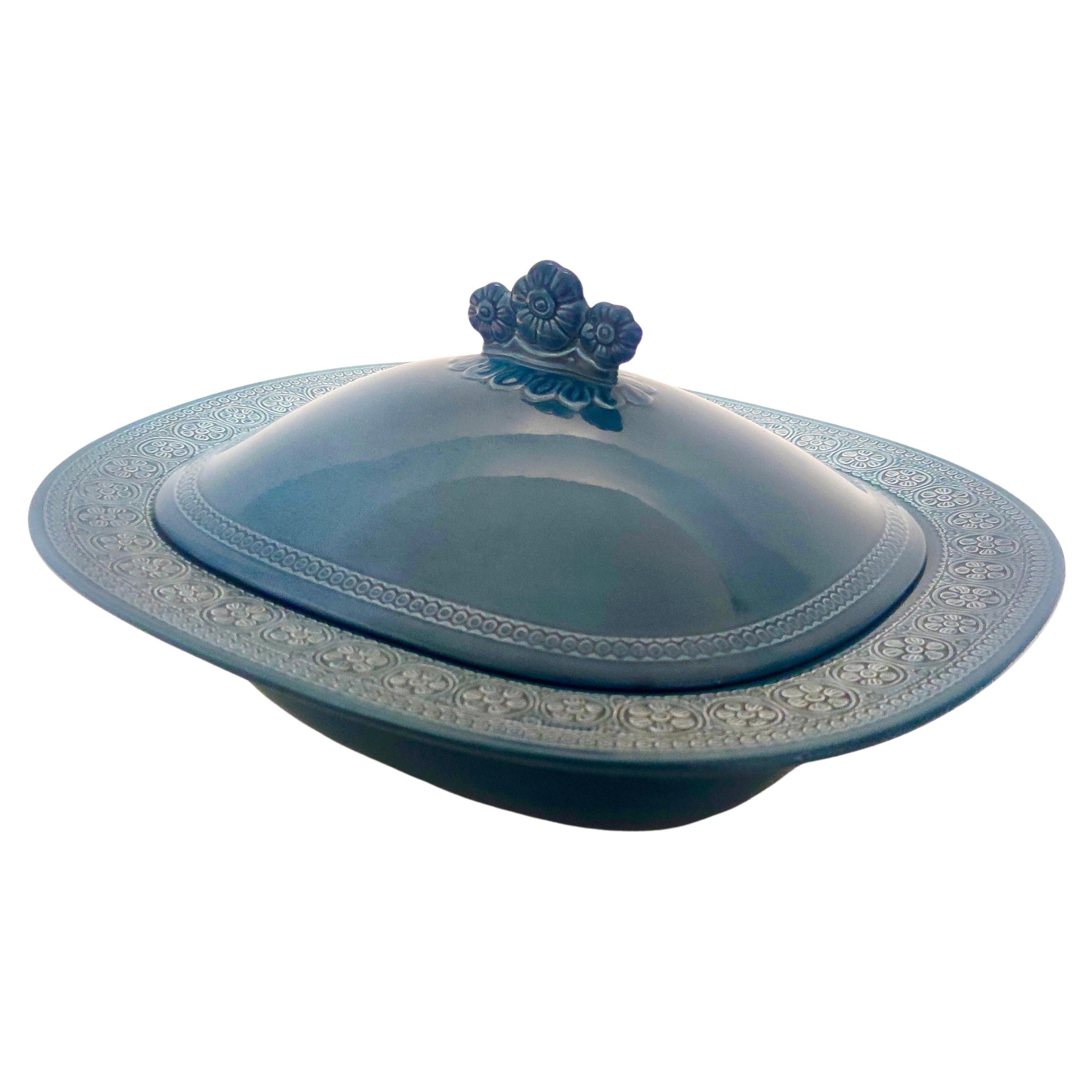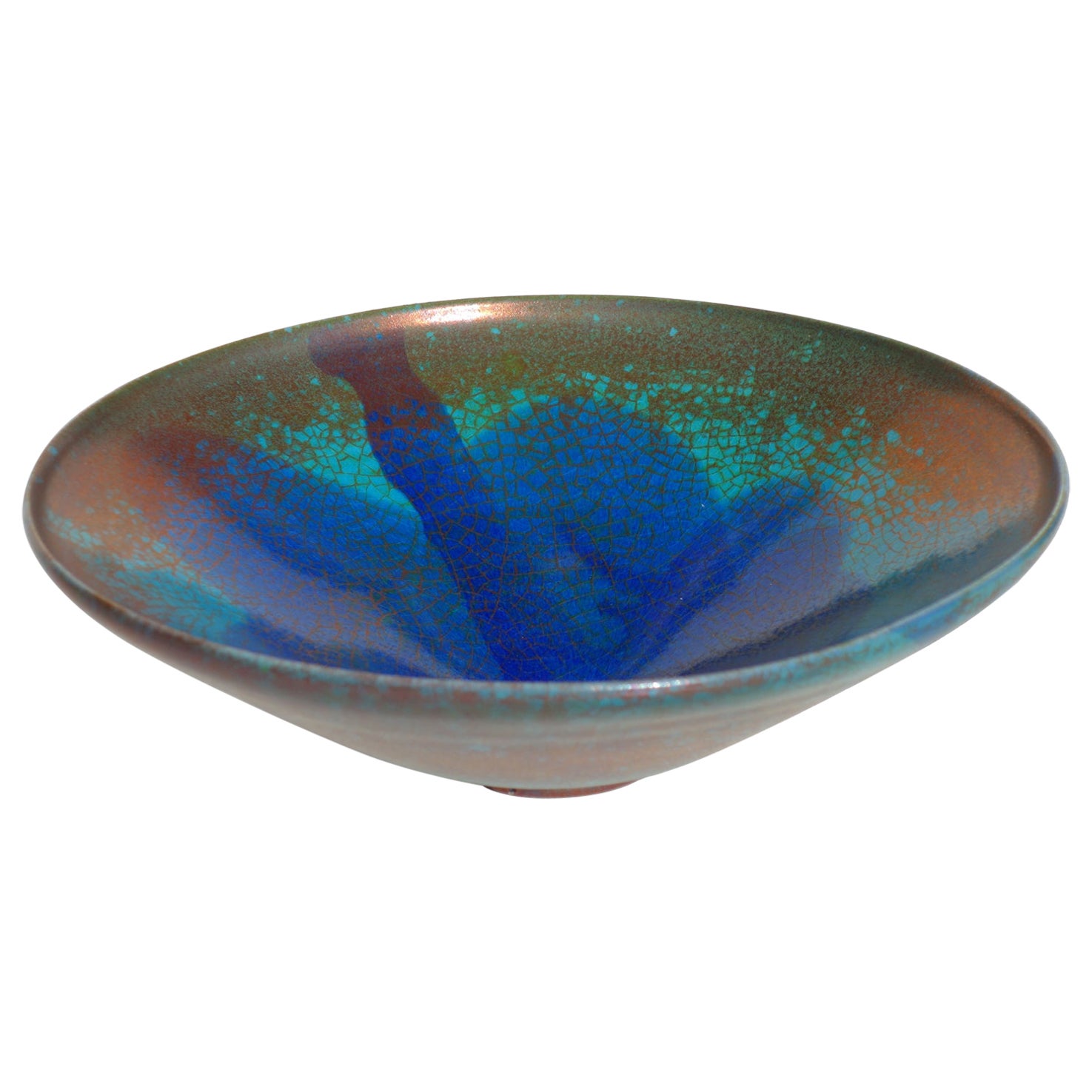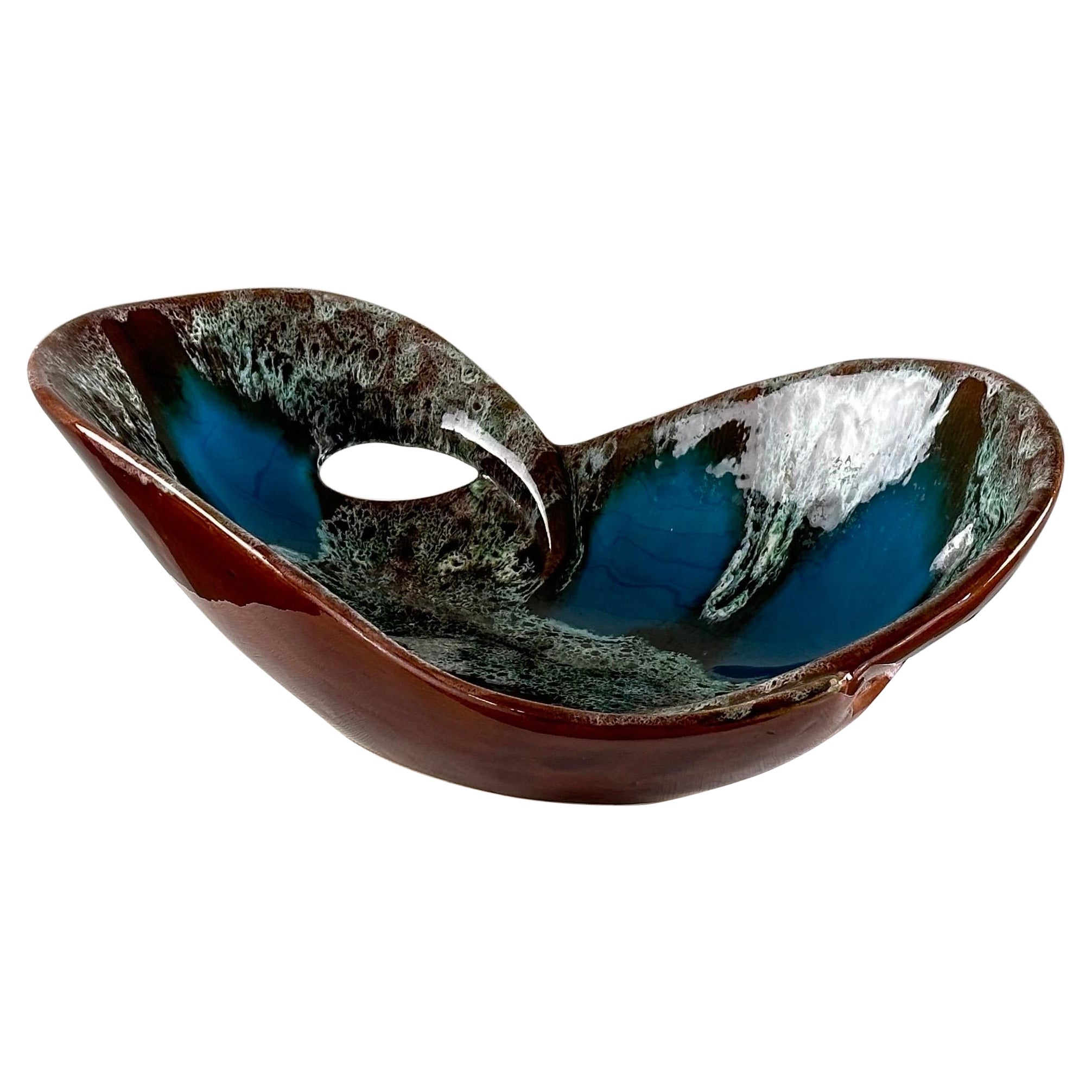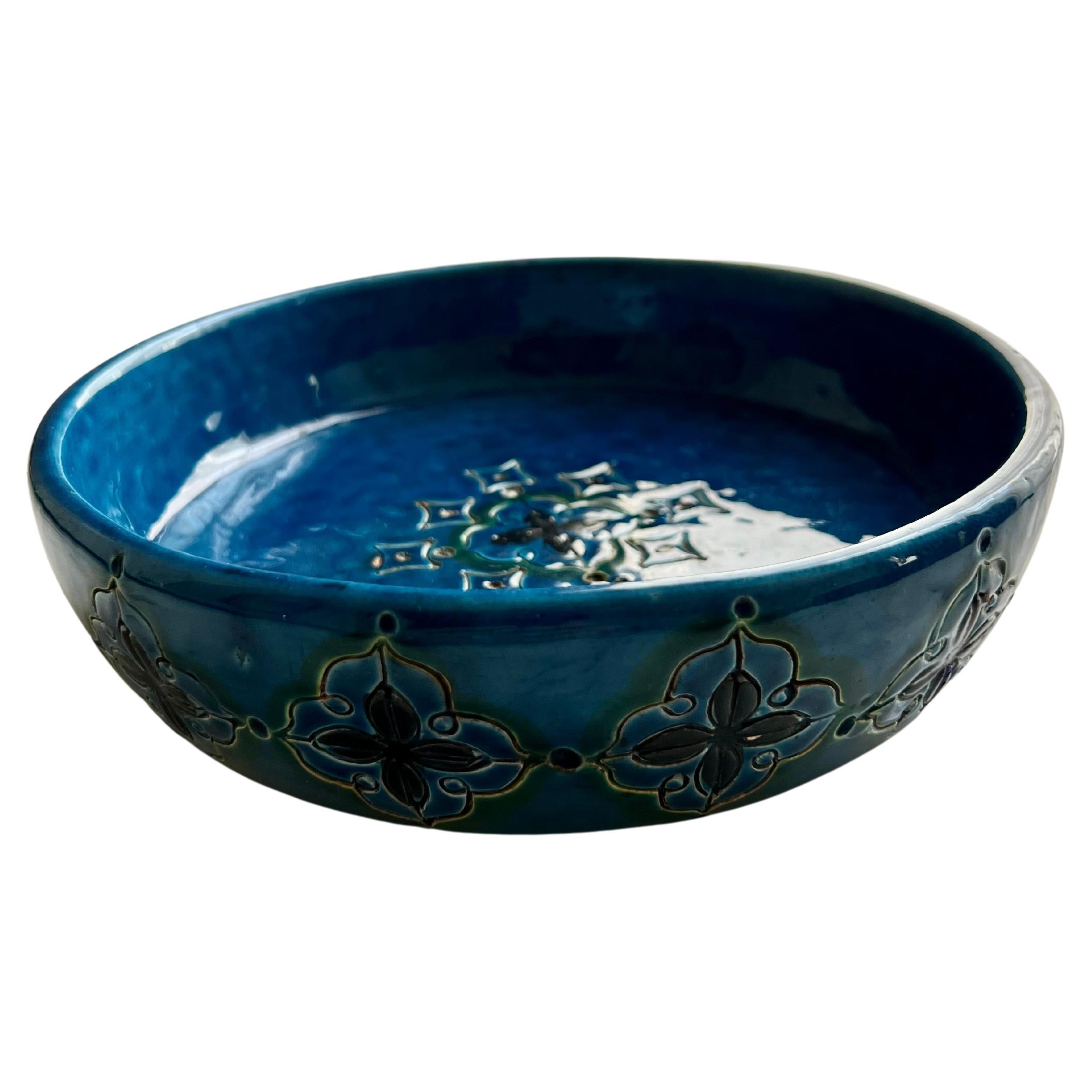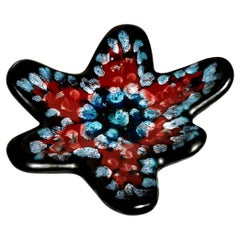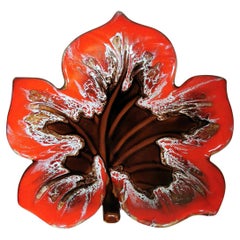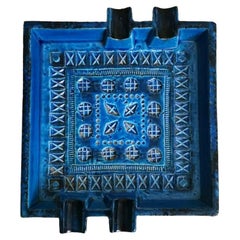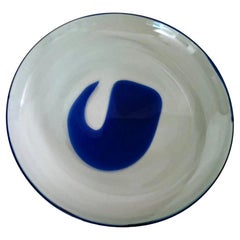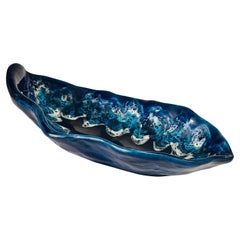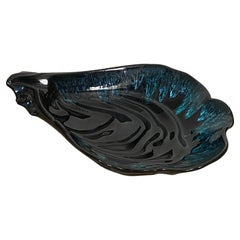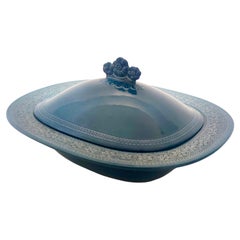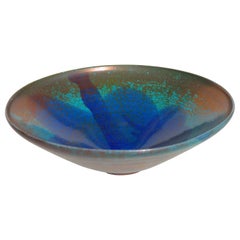Items Similar to Vallauris French Ceramic Centerpiece In Various Shades Of Blue
Video Loading
Want more images or videos?
Request additional images or videos from the seller
1 of 19
Vallauris French Ceramic Centerpiece In Various Shades Of Blue
$536.34
£397.16
€450
CA$737.55
A$820.35
CHF� 429.35
MX$10,005.50
NOK 5,394.95
SEK 5,074.65
DKK 3,425.99
About the Item
We kindly invite you to read the entire description, as we strive to provide detailed technical and historical information to ensure the authenticity of our items.
This captivating oval ceramic centerpiece in blue features a harmonious and well-balanced shape. However, what truly stands out is the exceptional combination of various shades of blue, creating a visually striking and dynamic effect. Crafted between 1970 and 1975 in one of the last remaining workshops in Vallauris, this piece bears the painted signature “Vallauris” and an impressed mark on the bottom edge, which also includes the name of the artist, Raymond Fassy. Vallauris, a town in the Provence-Alpes-Côte d’Azur region of southern France, is renowned for its long-standing tradition of ceramic craftsmanship. Although ceramic production in Vallauris dates back centuries, the town experienced a true artistic revival in the 20th century, attracting numerous artists and artisans. In the 1930s, Vallauris ceramics, originally designed for utilitarian purposes, underwent an aesthetic transformation, gradually evolving into genuine works of art. A pivotal moment for the town came in 1948 with the arrival of Pablo Picasso. Captivated by ceramics, Picasso relocated to Vallauris, where he remained until 1955, dedicating himself intensively to the craft and creating iconic works such as War and Peace. His presence, along with that of artists like Chagall and Miró, helped establish Vallauris as a prominent artistic hub. Among the local artisans, Raymond Fassy holds a distinguished place. Born on December 6, 1950, in Monaco, he spent his childhood in Antibes before permanently settling in Vallauris in 1968. In 1971, he met Maryse Parodi, with whom he shared a passion for ceramics. Fassy opened his workshop in the lower part of Avenue Clemenceau, where he created ceramics inspired by the style that made Vallauris famous in the 1950s and 1960s. His works, known for their original shapes and vibrant glazes, include decorative items such as shoe-shaped ashtrays and artistic trays. Unfortunately, like many other ceramists of his time, Fassy ceased his activity in March 2012. He passed away on December 10, 2019, leaving behind a significant legacy in the world of Vallauris ceramics. All pieces produced in the workshops of Vallauris are entirely handmade by skilled ceramists driven by deep passion. However, this ancient craft has significantly declined in recent decades: of the more than 250 ceramic workshops once active in the town, only a few remain today, preserving a tradition at risk of fading away. Despite this, Vallauris continues to celebrate its rich ceramic heritage through museums and ateliers. The Musée de la Céramique, for instance, offers visitors an overview of the evolution of local ceramics over the centuries, while the Madoura workshop, founded by Suzanne and Georges Ramié, houses a collection of works by Picasso and other contemporary artists. The town remains a key destination for ceramic enthusiasts, offering a unique blend of history, art, and craftsmanship. The centerpiece is in good condition.
Dimensions: Length: 12.2 in (31 cm) Width: 10.6 in (27 cm) Height: 1.6 in (4 cm)
For all our shipments, we use specialized packaging materials (wooden crates, polystyrene, etc.) to ensure maximum protection and safety for our items.
- Creator:Vallauris (Maker)
- Dimensions:Height: 1.58 in (4 cm)Width: 12.21 in (31 cm)Depth: 10.24 in (26 cm)
- Style:Mid-Century Modern (Of the Period)
- Materials and Techniques:
- Place of Origin:
- Period:
- Date of Manufacture:1970-1975
- Condition:Wear consistent with age and use. The centerpiece is in good condition.
- Seller Location:Prato, IT
- Reference Number:Seller: 169271stDibs: LU4632243545752
About the Seller
5.0
Platinum Seller
Premium sellers with a 4.7+ rating and 24-hour response times
Established in 1977
1stDibs seller since 2019
286 sales on 1stDibs
Typical response time: 1 hour
- ShippingRetrieving quote...Shipping from: PRATO, Italy
- Return Policy
Authenticity Guarantee
In the unlikely event there’s an issue with an item’s authenticity, contact us within 1 year for a full refund. DetailsMoney-Back Guarantee
If your item is not as described, is damaged in transit, or does not arrive, contact us within 7 days for a full refund. Details24-Hour Cancellation
You have a 24-hour grace period in which to reconsider your purchase, with no questions asked.Vetted Professional Sellers
Our world-class sellers must adhere to strict standards for service and quality, maintaining the integrity of our listings.Price-Match Guarantee
If you find that a seller listed the same item for a lower price elsewhere, we’ll match it.Trusted Global Delivery
Our best-in-class carrier network provides specialized shipping options worldwide, including custom delivery.More From This Seller
View AllLongwy Large French Glazed Ceramic Table Centerpiece Multicolor
By Faïenceries et Emaux de Longwy
Located in Prato, Tuscany
We kindly suggest you read the whole description, because with it we try to give you detailed technical and historical information to guarantee the authenticity of our objects.
Large...
Category
Vintage 1950s French Mid-Century Modern Ceramics
Materials
Terracotta
Vallauris France Colorful Ceramic Table Centerpiece Leaf Shaped
By Vallauris
Located in Prato, Tuscany
We kindly suggest you read the whole description, because with it we try to give you detailed technical and historical information to guarantee the authenticity of our objects.
A fas...
Category
Mid-20th Century French Mid-Century Modern Centerpieces
Materials
Ceramic
Bitossi by Aldo Londi Italian Vintage Ashtray Collection Flavia Montelupo
By Aldo Londi
Located in Prato, Tuscany
We kindly suggest you read the whole description, because with it we try to give you detailed technical and historical information to guarantee the authenticity of our objects.
Iconi...
Category
Mid-20th Century Italian Mid-Century Modern Ashtrays
Materials
Ceramic
Murano Glass Italian Empty Pockets (Tray) Round "Incamiciato"
Located in Prato, Tuscany
We kindly suggest that you read the entire description, as with it we try to give you detailed technical and historical information to ensure the authenticity of our objects.
Round Murano glass empty pockets (or tray); the design is essential but well-proportioned and elegant; pleasingly aesthetic is the effect of the two colors that artisans have managed to achieve with skill and mastery. This object was made by Murano masters using the technique of "incamiciatura," which consists of superimposing, as an initial process, on the glass mass that came out of the furnace, one or more successive layers of glass of different colors; in our object to the light blue, almost transparent glass mass, only the blue color was superimposed by immersing the white form just sketched in a crucible containing the blue molten glass. Then the Master glassmaker put the whole thing back in the furnace for a few minutes and then blew into the special barrel, helping himself with pliers and working it by hand he gave the pot emptier the desired shape shaping also the central decoration, even adding a thread of blue glass all along the edge, this operation was done flat, therefore much more difficult to make the two colors blend, the object was made entirely by hand and without the use of molds or models, thus creating a unique piece, just like a work of art. The earliest records of this technique concern Benedetto Barbaria, who in 1815 made "glass blown in two layers of enamel.". The object was created between 1970 and 1973 in Murano (Venice-Italy). As can be seen from the engraving on the rim, the pocket blank is a limited edition item; it is No. 34 of 150 pieces made, which, being all handmade, show differences from one another. Unfortunately, we cannot decipher the name of the design that created it for the Murano company Effe Due...
Category
Late 20th Century Italian Mid-Century Modern Glass
Materials
Murano Glass
Staffordshire Potteries English Tray with Blue Transferware Decorations
By Clementson Brothers
Located in Prato, Tuscany
We kindly suggest you read the whole description, because with it we try to give you detailed technical and historical information to guarantee the authenticity of our objects.
Lovely and refined English oval ceramic tray; elegant and rich blue decorations have been executed on the white background using the transferware method; the mark on the back tells us exactly that the object was produced by the Clementson Brothers LTD Company between 1901 and 1913 at the Phoenix factory in Shelton, the company made a wide range of objects with this decoration called "Delf" ( see mark no.909 p.150 of "Encyclopaedia of British Pottery and Porcelain Mark"). Transferware, which was very fashionable in the Victorian period, refers to glazed and decorated pottery with a specific treatment that they produced in Staffordshire, England; they used copper plates on which the design was engraved, the plate was then inked and the design transferred to a special fabric that was later placed on the pottery (plates, trays, tureens, etc.) which was glazed and fired; the first to use this printing process were John Sadler and Guy Green of Liverpool in 1756. If we look at the pottery made by this method we will notice that the designs are not perfect and often the ink is smudged: this is their characteristic. A hand-painted plate service could afford few English families, with this method even middle-class families could have a decorated plate service. The Clementson Firm was founded in 1839 by Joseph Clementson, who retired from the business in 1867, leaving the factory to his four sons and son...
Category
Early 20th Century British Victorian Ceramics
Materials
Ceramic
Murano Italian Colored Opaline Glass Basket
Located in Prato, Tuscany
We kindly suggest that you read the whole description, as with it we try to give you detailed technical and historical information to guarantee the authenticity of our objects.
Pret...
Category
Mid-20th Century Italian Mid-Century Modern Glass
Materials
Murano Glass, Opaline Glass
You May Also Like
Large Ceramic Blue Vide Poche or Central piece Circa 1960 France
Located in Auribeau sur Siagne, FR
Title: Large Ceramic Centerpiece or Catchall, Vallauris, France, 1960s
Description:
This stunning large ceramic piece, crafted in Vallauris, France, during the 1960s, is a remarkable example of mid-century French artistry. Both functional and decorative, this centerpiece or catchall evokes the beauty of the sea through its unique form and vibrant colors.
Key features include:
Design and Inspiration: The shimmering blue glaze, reminiscent of the ocean, contrasts beautifully with the natural white ceramic, creating a striking maritime-inspired aesthetic. The piece features an organic, sculptural design with an open section that doubles as a handle, adding both visual interest and practicality.
Craftsmanship: Handcrafted in the renowned pottery town of Vallauris, this piece reflects the region's legacy of excellence in ceramic art. The attention to detail and high-quality glazing showcase the expertise of 1960s French artisans.
Versatility: Perfect as a catchall, fruit bowl, or centerpiece, this ceramic piece makes a statement on dining tables, coffee tables, or display shelves. Its bold design integrates effortlessly into modern, coastal, or mid-century interiors.
Colors and Finish: The shimmering blue glaze brings life and movement to the piece, while the smooth white ceramic base provides a serene and balanced look.
A true blend of form and function, this Vallauris ceramic piece captures the essence of 1960s design while offering versatile utility. Its unique design and vibrant colors make it a must-have for collectors or anyone looking to add a touch of French artistry to their home.
Keywords: Vallauris ceramic centerpiece, 1960s French pottery, blue and white catchall...
Category
Vintage 1960s French Mid-Century Modern Ashtrays
Materials
Ceramic
$333 Sale Price
20% Off
Large Ceramic Blue Vide Poche or Central piece Shell Form Circa 1960 France
Located in Auribeau sur Siagne, FR
This Ceramic Central piece or Vide Poche, has a shell Shape. The colors are the blue.
It has been made in France Circa 1960
Category
Vintage 1960s French Mid-Century Modern Ashtrays
Materials
Ceramic
$333 Sale Price
20% Off
Vintage Blue Earthenware "Margherita" Centerpiece by A. Campi for Laveno, Italy
By Antonia Campi, S.C.I. Laveno
Located in Bresso, Lombardy
Made in Italy in 1965 by Antonia Campi for Laveno. It is marked on the bottom.
This centerpiece bowl is made in blue lacquered earthenware with bossed decorations.
This is a vintage...
Category
Vintage 1960s Italian Mid-Century Modern Serving Pieces
Materials
Earthenware
1970 Carlo Zauli Faenza Italian Ceramic Enamel Blue Turquoise Copper Plate
By Carlo Zauli
Located in Brescia, IT
Carlo Zauli
Faenza, 1970
Ceramic Dish
Metallic enamels and in shades of blue
Artist's signature at the base
Perfette condizioni
Category
Vintage 1970s Italian Mid-Century Modern Dinner Plates
Materials
Ceramic
Exquisite Enamelled Ceramic Table Center from Vallauris, France, 1960s
By Vallauris AM
Located in Brescia, Brescia
Indulge in the timeless charm of mid-century French craftsmanship with this exquisite enamelled ceramic table center from Vallauris, France. Crafted with meticulous attention to deta...
Category
Vintage 1960s French Mid-Century Modern Centerpieces
Materials
Ceramic
Blue Italian Ceramic Dish in the Style of Bitossi Raymor
By Bitossi
Located in Los Angeles, CA
Italian blue glazed ceramic bowl or dish. Classic mediterranean ceramic design featuring blue, green, and navy glazes. Stunning when full of l...
Category
20th Century Italian Mid-Century Modern Ceramics
Materials
Ceramic
More Ways To Browse
Ceramics Of Monaco
Alpes Furniture
Picasso Ceramique
1950s French Shoes
Shoe Last
Atelier Madoura
Exp Signed Ceramic Pottery
Fantasia Italiana
Faux Bois Pitcher
George Jones Majolica Strawberry
Ironstone Water Lily
Mason Water Lily Pattern
Mason Water Lily
Masons Flying Bird
Masons Ironstone Water Lily
Masons Pheasant
Montelupo Plates
Scheier Ceramics
